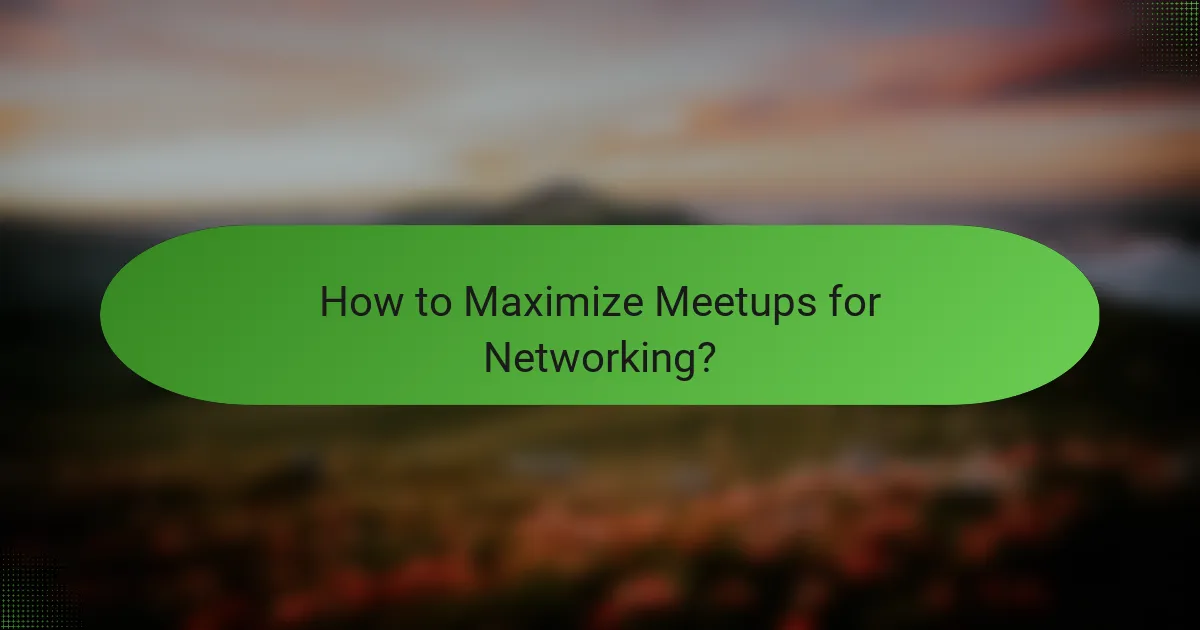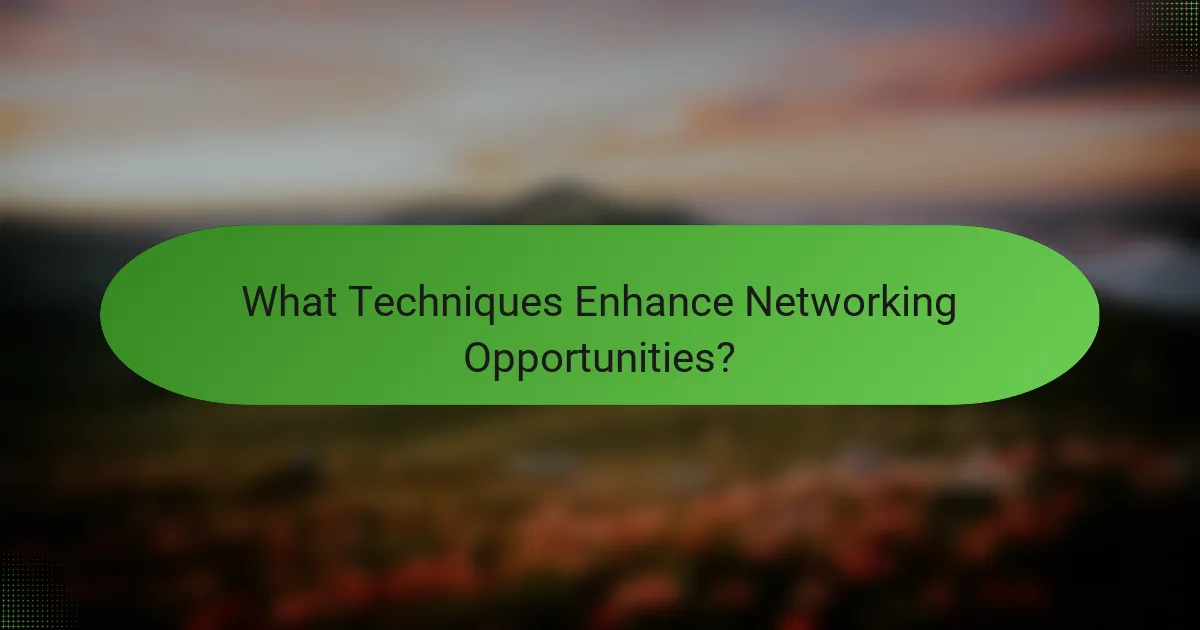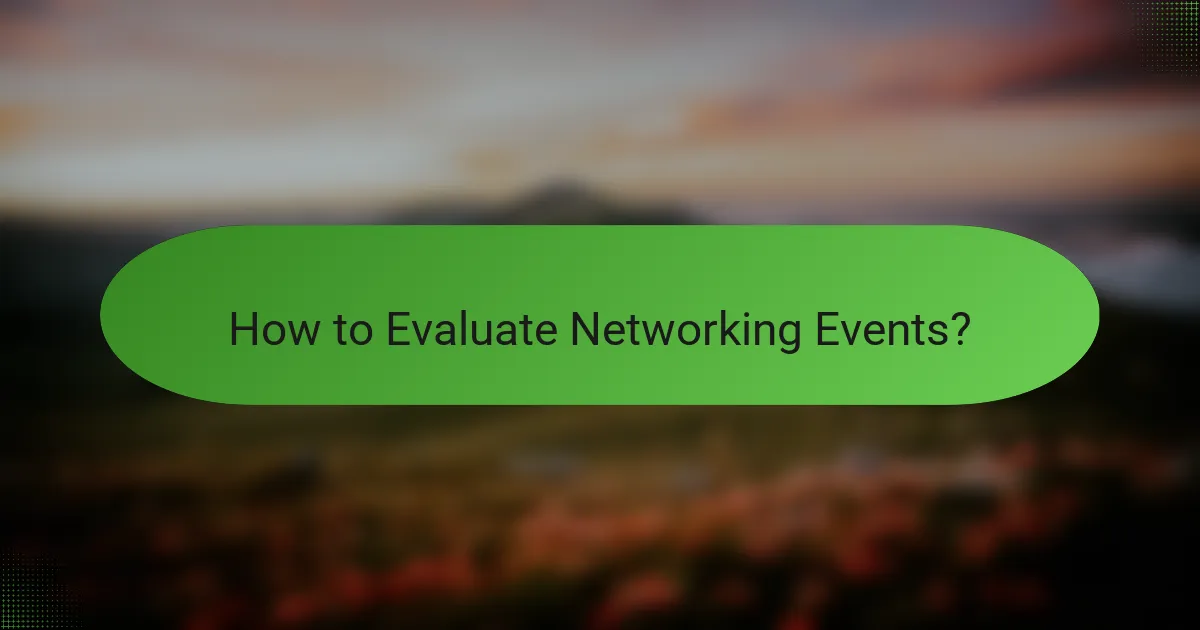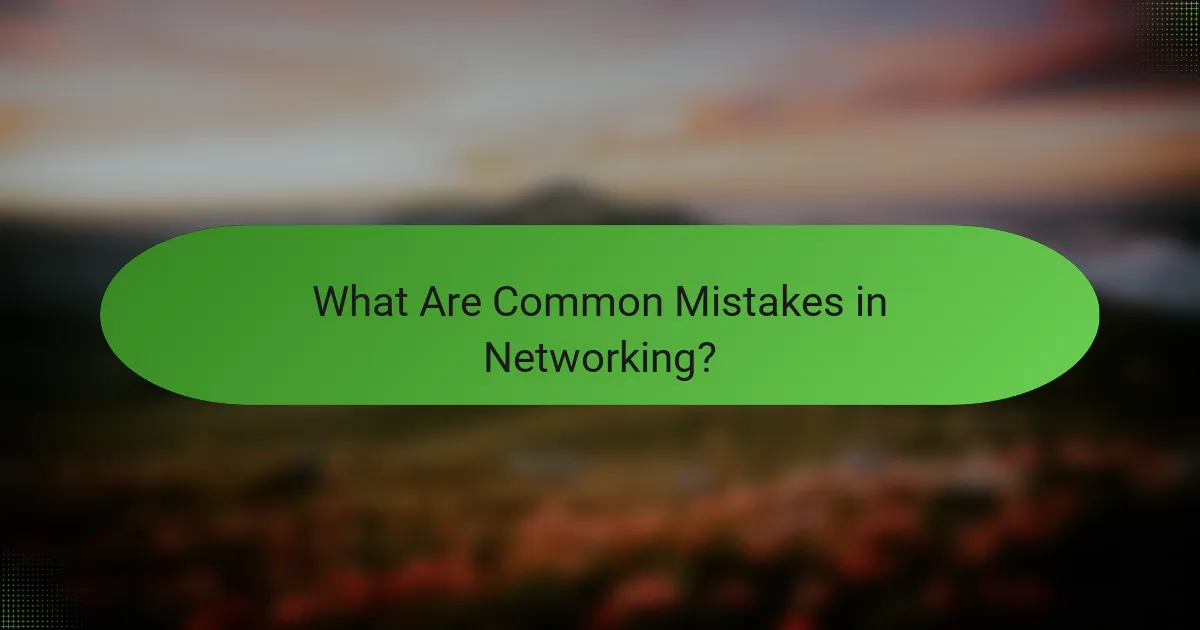Networking at conferences and meetups is essential for building meaningful professional relationships and expanding your opportunities. By focusing on genuine engagement, utilizing social media, and honing your communication skills, you can enhance your networking effectiveness. Implementing strategies like active listening and crafting a compelling elevator pitch will further help you make lasting connections in your field.

What Are Effective Networking Strategies for Conferences?
Effective networking strategies for conferences focus on building genuine relationships, utilizing social media, and maintaining connections after the event. These approaches help attendees maximize their networking potential and create lasting professional ties.
Building meaningful connections
To build meaningful connections at conferences, prioritize quality over quantity. Engage in conversations that go beyond small talk; ask open-ended questions and listen actively to understand others’ perspectives. Aim to connect with individuals who share similar interests or professional goals.
Consider setting specific goals for each event, such as meeting a certain number of people or connecting with key industry figures. This targeted approach can help you stay focused and make the most of your time.
Leveraging social media
Social media is a powerful tool for enhancing your networking efforts at conferences. Use platforms like LinkedIn and Twitter to connect with attendees before, during, and after the event. Share relevant content and engage with others’ posts to increase your visibility and establish rapport.
During the conference, consider using event-specific hashtags to join conversations and share insights. This can help you connect with other attendees and industry leaders, expanding your network beyond in-person interactions.
Following up post-event
Following up after a conference is crucial for solidifying connections. Send personalized messages to individuals you met, referencing specific topics you discussed to jog their memory. A simple thank-you note or a message sharing an article related to your conversation can go a long way.
Consider scheduling a follow-up call or meeting to explore collaboration opportunities. Keeping the conversation going will help you maintain relationships and potentially lead to future partnerships or job opportunities.

How to Maximize Meetups for Networking?
To maximize meetups for networking, focus on selecting relevant events, actively engaging with participants, and utilizing effective icebreakers. These strategies enhance your connections and increase the likelihood of meaningful interactions.
Choosing the right meetups
Selecting the right meetups is crucial for effective networking. Look for events that align with your professional interests or industry, as this increases the chances of meeting like-minded individuals. Utilize platforms like Meetup.com or Eventbrite to find gatherings that cater to your specific goals.
Consider the size and format of the meetup. Smaller, more intimate gatherings often allow for deeper conversations, while larger events may offer a broader range of contacts. Aim for a mix of both types to diversify your networking opportunities.
Engaging with speakers and attendees
Engagement is key to making lasting connections at meetups. Approach speakers after their presentations to ask insightful questions or share your thoughts on their topics. This not only shows your interest but also helps you stand out.
When interacting with other attendees, be genuine and open. Introduce yourself with a brief personal pitch, highlighting your background and interests. Listen actively and ask follow-up questions to foster deeper discussions.
Utilizing icebreakers
Icebreakers can ease the tension in networking situations and facilitate conversations. Prepare a few open-ended questions or fun facts about yourself to share, which can prompt others to engage. For example, asking about recent industry trends or favorite projects can spark interesting dialogues.
Additionally, consider using situational icebreakers related to the event, such as commenting on the venue or the speaker’s presentation. This creates a natural segue into more substantial topics and helps build rapport quickly.

What Techniques Enhance Networking Opportunities?
Effective networking techniques can significantly boost your opportunities to connect with others in your field. Key strategies include honing your active listening skills, developing a strong personal brand, and crafting an effective elevator pitch.
Active listening skills
Active listening is crucial for building meaningful connections. It involves fully concentrating on the speaker, understanding their message, responding thoughtfully, and remembering key details for future conversations.
To practice active listening, maintain eye contact, nod in acknowledgment, and ask clarifying questions. This not only shows your engagement but also encourages the speaker to share more, deepening the interaction.
Personal branding strategies
Personal branding is about presenting yourself in a way that highlights your unique skills and values. A strong personal brand can make you memorable and help others understand what you bring to the table.
Consider creating a consistent online presence through social media and professional platforms like LinkedIn. Share insights related to your expertise, engage with others in your industry, and ensure your profile reflects your professional goals.
Effective elevator pitches
An elevator pitch is a brief, persuasive speech that you can use to spark interest in what you or your organization does. It should be concise, typically lasting around 30 seconds, and clearly communicate your value proposition.
When crafting your pitch, focus on your unique selling points and tailor it to your audience. Practice delivering it confidently, and be prepared to adapt based on the listener’s reactions or questions. Avoid jargon and keep it relatable to ensure clarity and engagement.

What Are the Best Tools for Networking Management?
The best tools for networking management streamline the process of connecting with professionals, organizing events, and maintaining relationships. These tools enhance visibility and facilitate meaningful interactions, making networking more efficient and effective.
LinkedIn for professional connections
LinkedIn is a premier platform for building and managing professional connections. It allows users to create detailed profiles, showcase their skills, and connect with colleagues, industry leaders, and potential employers.
To maximize your LinkedIn experience, regularly update your profile, engage with posts, and join relevant groups. Sending personalized connection requests can significantly increase your acceptance rate and foster stronger relationships.
Eventbrite for finding events
Eventbrite is a popular tool for discovering networking events, workshops, and conferences in your area. Users can search for events by location, date, and category, making it easy to find opportunities that align with their interests.
When using Eventbrite, consider setting up alerts for specific types of events or topics. This proactive approach ensures you never miss out on valuable networking opportunities that could advance your career.
Networking apps like Shapr
Shapr is a networking app designed to connect professionals based on shared interests and goals. Users create profiles and swipe through potential connections, similar to dating apps, allowing for quick and easy networking.
To effectively use Shapr, be clear about your interests and what you seek in connections. Engaging in meaningful conversations after matching can lead to fruitful relationships and collaborations.

How to Evaluate Networking Events?
To evaluate networking events effectively, consider the attendee demographics, the goals of the event, and the success of previous iterations. These factors will help you determine if the event aligns with your networking objectives and if it is worth your time and investment.
Assessing attendee demographics
Understanding the demographics of attendees is crucial for evaluating networking events. Look for information on the industries represented, job levels, and geographic locations of participants. For example, if you are in tech, an event with a high percentage of software engineers and product managers may be more beneficial than one dominated by marketing professionals.
Additionally, consider the size of the event. Smaller gatherings often allow for more meaningful interactions, while larger conferences may offer a broader range of contacts but less personal engagement. Aim for events where the attendee profile matches your networking goals.
Understanding event goals
Each networking event has specific goals that can influence its effectiveness. Some may focus on knowledge sharing, while others prioritize lead generation or collaboration opportunities. Clarifying these objectives can help you assess whether the event aligns with your own professional aims.
Review the event agenda and speaker lineup to gauge how well they support the stated goals. If the event emphasizes workshops or breakout sessions, it may offer more hands-on networking opportunities compared to a lecture-style format.
Reviewing past event success
Investigating the success of previous events can provide valuable insights into what to expect. Look for testimonials, case studies, or statistics that highlight attendee satisfaction and outcomes. For instance, if past attendees report significant connections or business deals resulting from the event, it may be worth considering.
Check if the event organizers share metrics such as attendee growth or engagement levels over the years. Consistent improvement in these areas often indicates a well-managed event that could be beneficial for your networking efforts.

What Are Common Mistakes in Networking?
Common mistakes in networking often hinder relationship building and can lead to missed opportunities. Key errors include failing to follow up with contacts and adopting an overly sales-focused approach that can alienate potential connections.
Not following up
Not following up after an initial meeting is a significant networking mistake. Without follow-up, the connection may fade, and the opportunity to build a relationship is lost. A simple email or message expressing appreciation for the conversation can keep the dialogue open.
Consider setting a reminder to reach out within a week of meeting someone. This can be as straightforward as sharing a relevant article or suggesting a coffee chat to discuss mutual interests further.
Being overly sales-focused
Being overly sales-focused during networking events can push potential contacts away. Instead of fostering genuine connections, a hard-sell approach often creates discomfort and distrust. Networking should prioritize relationship building over immediate sales goals.
To avoid this pitfall, aim to listen actively and engage in meaningful conversations. Ask questions about the other person’s interests and needs, and share insights that can help them, rather than immediately pitching your services or products.
